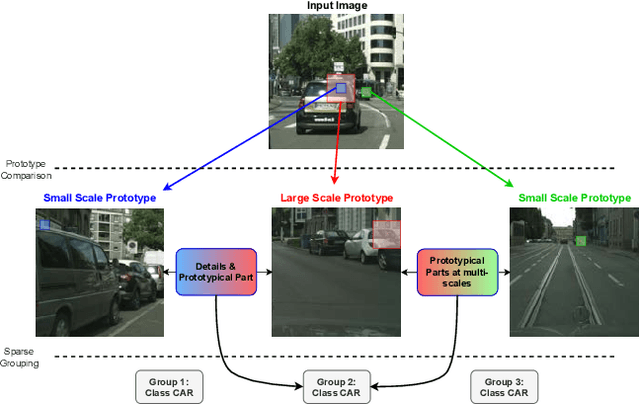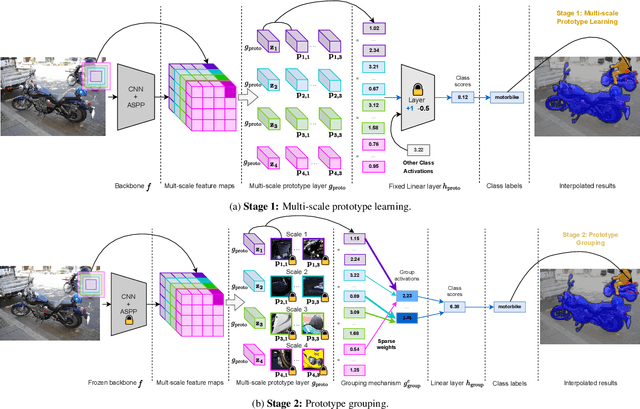Hugo Porta
Multi-Scale Grouped Prototypes for Interpretable Semantic Segmentation
Sep 14, 2024



Abstract:Prototypical part learning is emerging as a promising approach for making semantic segmentation interpretable. The model selects real patches seen during training as prototypes and constructs the dense prediction map based on the similarity between parts of the test image and the prototypes. This improves interpretability since the user can inspect the link between the predicted output and the patterns learned by the model in terms of prototypical information. In this paper, we propose a method for interpretable semantic segmentation that leverages multi-scale image representation for prototypical part learning. First, we introduce a prototype layer that explicitly learns diverse prototypical parts at several scales, leading to multi-scale representations in the prototype activation output. Then, we propose a sparse grouping mechanism that produces multi-scale sparse groups of these scale-specific prototypical parts. This provides a deeper understanding of the interactions between multi-scale object representations while enhancing the interpretability of the segmentation model. The experiments conducted on Pascal VOC, Cityscapes, and ADE20K demonstrate that the proposed method increases model sparsity, improves interpretability over existing prototype-based methods, and narrows the performance gap with the non-interpretable counterpart models. Code is available at github.com/eceo-epfl/ScaleProtoSeg.
From Classification to Segmentation with Explainable AI: A Study on Crack Detection and Growth Monitoring
Sep 20, 2023Abstract:Monitoring surface cracks in infrastructure is crucial for structural health monitoring. Automatic visual inspection offers an effective solution, especially in hard-to-reach areas. Machine learning approaches have proven their effectiveness but typically require large annotated datasets for supervised training. Once a crack is detected, monitoring its severity often demands precise segmentation of the damage. However, pixel-level annotation of images for segmentation is labor-intensive. To mitigate this cost, one can leverage explainable artificial intelligence (XAI) to derive segmentations from the explanations of a classifier, requiring only weak image-level supervision. This paper proposes applying this methodology to segment and monitor surface cracks. We evaluate the performance of various XAI methods and examine how this approach facilitates severity quantification and growth monitoring. Results reveal that while the resulting segmentation masks may exhibit lower quality than those produced by supervised methods, they remain meaningful and enable severity monitoring, thus reducing substantial labeling costs.
 Add to Chrome
Add to Chrome Add to Firefox
Add to Firefox Add to Edge
Add to Edge